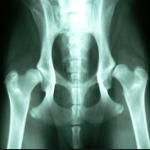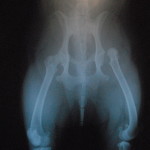PennHip is a multifaceted radiographic screening method for hip evaluation. The PennHip method is a novel way to assess, measure, and interpret hip joint laxity.
- This technique for evaluation is more accurate than the current standard in its ability to predict the onset of osteoarthritis (OA).
- Osteoarthritis, also known as degenerative joint disease (DJD), is the hallmark of hip dysplasia.
- PennHip is more than just a radiographic technique. It is network of veterinarians trained to perform the PennHip methodology properly and, perhaps most importantly, it is a large scientific database that houses the PennHip data.
What is involved in getting PennHip films on my dog?
The procedure is an out-patient same day procedure which involves brief anesthesia and three separate radiographs. After we obtain the radiographs, your animal will be waken up and returned back to you the same day. The radiographs are then mailed to Antech PennHip for evaluation. You should expect results in 10-14 days.
Is my animal a candidate for PennHip evaluation?
- Any dog 16 weeks of age or older can have PennHip films done.
- Your dog is a candidate for PennHip evaluation if you want or need information concerning his hips.
- We especially recommend evaluation on any breeding animal over the age of 16 weeks of age prior to their first breeding.
- Due to the young age requirement, you can also use this technique as a pre-purchase screening tool.
FAQ’S
- The looser the joint is on a canine patient, the greater the chance that the hip will develop OA.
- The standard hip extended view, when evaluated alone, tends to mask true hip laxity.
- Hip dysplasia is extremely common, but if detected early, will allow us to develop appropriate breeding strategies aimed at reducing the frequency and severity of the condition.
- The distraction index (DI) as determined by PennHip method is the most reliable indicator of future hip osteoarthritis.
- PennHip method can be reliably performed on a dog as young as 16 weeks old.
- 80% of dogs evaluated as normal by the OFA were found to have hip laxity by PennHip testing that predisposed them to develop hip osteoarthritis in the
Hip Dysplasia
Canine hip dysplasia (CHD) is an abnormal development of the hip causing excessive wear of the joint cartilage during weight bearing, eventually leading to the development of arthritis.
- The development of this arthritis or degenerative joint disease (DJD) is what causes the clinical symptoms of canine hip dysplasia.
- The general veterinary consensus is that hip dysplasia is a heritable disease manifested as hip joint laxity that leads to the development of DJD.
- Canine hip dysplasia afflicts millions of dogs each year and can result in debilitating orthopedic disease of the hip.
- This is a disease of complex inheritance that is caused by many genes.
- The occurrence of CHD is well documented in the large and giant breed dogs, but there is also evidence that CHD is prevalent in many small and toy breeds as well.
- Severe Hip Dysplasia
- Luxated Hip Joint
Facts about hip dysplasia
- Canine hip dysplasia (CHD) is the most commonly inherited orthopedic disease in dogs. CHD is a degenerative condition, leading to painful hip osteoarthritis, stiffness, and diminished quality of life.
- All dog breeds are affected by the disease, in some breeds more than 50% of dogs are affected.
- The disease is polygenic and multifactorial.
- The development of CHD is affected by environmental factors such as weight and age.
- There is no medical or surgical cure for CHD.
- CHD is a major concern for working dogs, pet owners, breeders, and veterinarians. Keeping your dog at a lean weight throughout life delays the onset of hip osteoarthritis related to hip dysplasia.


